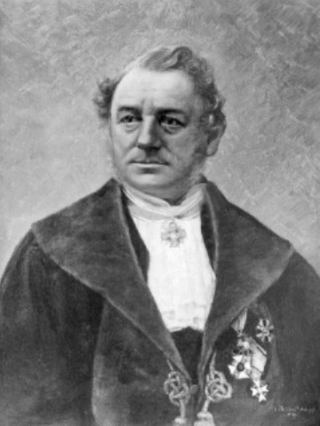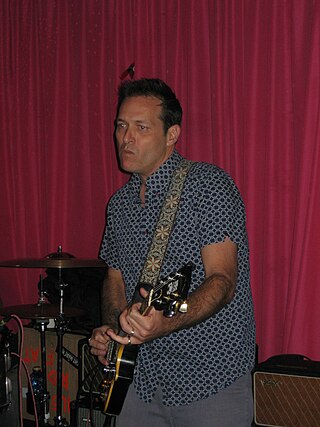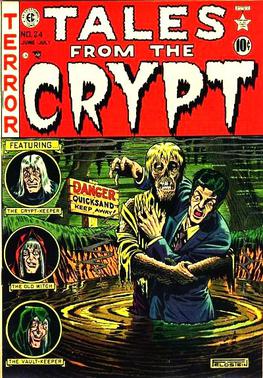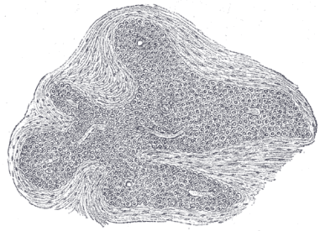Related Research Articles

The large intestine, also known as the large bowel, is the last part of the gastrointestinal tract and of the digestive system in tetrapods. Water is absorbed here and the remaining waste material is stored in the rectum as feces before being removed by defecation. The colon is the longest portion of the large intestine, and the terms are often used interchangeably but most sources define the large intestine as the combination of the cecum, colon, rectum, and anal canal. Some other sources exclude the anal canal.

A crypt is a stone chamber beneath the floor of a church or other building. It typically contains coffins, sarcophagi, or religious relics.

Tales from the Crypt, sometimes titled HBO's Tales from the Crypt, is an American horror anthology television series that ran from June 10, 1989, to July 19, 1996, on the premium cable channel HBO for seven seasons with a total of 93 episodes. It was executive produced by Joel Silver, Richard Donner, Robert Zemeckis, Walter Hill and David Giler. The first two seasons were produced by William Teitler. Beginning the show's third season, HBO and the Crypt Partners hired Gilbert Adler and A L Katz to take over the show. Adler and Katz ran Crypt through to its conclusion five seasons and 69 episodes later.
Source-available software is software released through a source code distribution model that includes arrangements where the source can be viewed, and in some cases modified, but without necessarily meeting the criteria to be called open-source. The licenses associated with the offerings range from allowing code to be viewed for reference to allowing code to be modified and redistributed for both commercial and non-commercial purposes.

Rocket from the Crypt is an American punk rock band from San Diego, California, originally active from 1990 to 2005, then active during 2011 and again from 2013 to the present.

TrueCrypt is a discontinued source-available freeware utility used for on-the-fly encryption (OTFE). It can create a virtual encrypted disk within a file, or encrypt a partition or the whole storage device.

Hubert von Luschka, born Hubert Luschka, was a German anatomist. He lent his name to several structures, including the foramina of Luschka, Luschka's crypts, Luschka's joints, and Ducts of Luschka. His name is also associated with Luschka's law, an anatomical rule concerning location of the ureters.

Tales from the Crypt is a 1972 British horror film directed by Freddie Francis. It is an anthology film consisting of five separate segments, based on the Tales from the Crypt short stories by Al Feldstein, Johnny Craig, and Bill Gaines. The film was produced by Amicus Productions and filmed at Shepperton Studios in Surrey, England.
In anatomy, Luschka's joints are formed between uncinate process or "uncus" below and uncovertebral articulation above. They are located in the cervical region of the vertebral column from C3 to C7. Two lips project upward from the superior surface of the vertebral body below, and one projects downward from the inferior surface of vertebral body above. They allow for flexion and extension and limit lateral flexion in the cervical spine.

John Reis, also known by the pseudonyms Speedo, Slasher, and the Swami is an American musician, singer, guitarist, record label owner, and disc jockey. He is best known as the singer and guitarist for the rock band Rocket from the Crypt, which he formed and fronted for the entirety of its career from 1990 to 2005. Prior to this he was the guitarist in the post-hardcore band Pitchfork, and also played in Drive Like Jehu during the early 1990s. In 1999 he formed the Hot Snakes, and in 2000 also formed the Sultans, in which he sang and originally played bass before switching to rhythm guitar. He played in both these bands until their breakups in 2005 and 2007 respectively. He also released a solo recording under the name Back Off Cupids, which was recorded in 1994 but not released until 1999. Over the years he has performed in many other musical acts including Conservative Itch, Stacatto Reads, Custom Floor, and Beehive & the Barracudas. He is the owner of Swami Records, a label he founded in 1999. He frequently works with bands in a studio capacity and releases albums by many southern California groups through his label. He also hosts the "Swami Sound System" program. Reis remains an influential figure in the San Diego underground music community and is currently performing with San Diego bands the Night Marchers and PLOSIVS, with Rob Crow.

Tales from the Crypt was an American bi-monthly horror comic anthology series published by EC Comics from 1950 to 1955, producing 27 issues. Along with its sister titles, The Haunt of Fear and The Vault of Horror, Tales from the Crypt was popular, but in the late 1940s and early 1950s comic books came under attack from parents, clergymen, schoolteachers and others who believed the books contributed to illiteracy and juvenile delinquency. In April and June 1954, highly publicized congressional subcommittee hearings on the effects of comic books upon children left the industry shaken. With the subsequent imposition of a highly restrictive Comics Code, EC Comics publisher Bill Gaines cancelled Tales from the Crypt and its two companion horror titles, along with the company's remaining crime and science fiction series in September 1954.
An accessory bile duct is a conduit that transports bile and is considered to be supernumerary or auxiliary to the biliary tree.

In histology, an intestinal gland is a gland found in between villi in the intestinal epithelium lining of the small intestine and large intestine. The glands and intestinal villi are covered by epithelium, which contains multiple types of cells: enterocytes, goblet cells, enteroendocrine cells, cup cells, tuft cells, and at the base of the gland, Paneth cells and stem cells.

The lateral aperture of the fourth ventricle or foramen of Luschka is an opening at the lateral extremity of either lateral recess of the fourth ventricle opening anteriorly into the pontine cistern/lateral cerebellomedullary cistern at cerebellopontine angle. A tuft of choroid plexus commonly extends into the lateral aperture, partially obstructing CSF flow through this aperture.

The coccygeal glomus is a vestigial structure placed in front of, or immediately below, the tip of the coccyx.
This is a technical feature comparison of different disk encryption software.
dm-crypt is a transparent block device encryption subsystem in Linux kernel versions 2.6 and later and in DragonFly BSD. It is part of the device mapper (dm) infrastructure, and uses cryptographic routines from the kernel's Crypto API. Unlike its predecessor cryptoloop, dm-crypt was designed to support advanced modes of operation, such as XTS, LRW and ESSIV, in order to avoid watermarking attacks. In addition to that, dm-crypt addresses some reliability problems of cryptoloop.
TrueCrypt is based on Encryption for the Masses (E4M), an open source on-the-fly encryption program first released in 1997. However, E4M was discontinued in 2000 as the author, Paul Le Roux, began working on commercial encryption software.

VeraCrypt is a free and open-source utility for on-the-fly encryption (OTFE). The software can create a virtual encrypted disk that works just like a regular disk but within a file. It can also encrypt a partition or the entire storage device with pre-boot authentication.
References
- ↑ "Luschka's crypts". TheFreeDictionary.com. Retrieved 23 January 2017.
- ↑ Haubrich, William S. (April 2007). "Luschka of the Crypts of Luschka". Gastroenterology. 132 (4): 1216. doi: 10.1053/j.gastro.2007.02.063 .